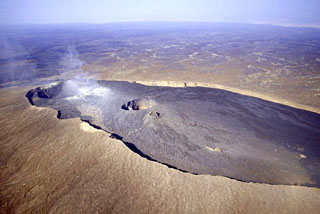Report on Erta Ale (Ethiopia) — September 1992
Bulletin of the Global Volcanism Network, vol. 17, no. 9 (September 1992)
Managing Editor: Lindsay McClelland.
Erta Ale (Ethiopia) Lava lake in one of two summit-caldera craters; recent lava overflows of caldera rim
Please cite this report as:
Global Volcanism Program, 1992. Report on Erta Ale (Ethiopia) (McClelland, L., ed.). Bulletin of the Global Volcanism Network, 17:9. Smithsonian Institution. https://doi.org/10.5479/si.GVP.BGVN199209-221080
Erta Ale
Ethiopia
13.601°N, 40.666°E; summit elev. 585 m
All times are local (unless otherwise noted)
The [September] flight covered the Afar region from the Alebbagu and Hayli Gubbi volcanoes, to lakes Ba Kili and Karum. The N half of Erta Ale's elliptical caldera included two craters. The larger, ~300 m in diameter, was in the northernmost part of the caldera. Two strong fumaroles were active near its S rim, but no lava lake was evident. Two dark fresh-looking lava flows had originated from this crater; one had flowed over the caldera rim to the NNE, the other, to the SW, was confined by the caldera's W wall. A lava lake was observed in the second of the two craters, near the middle of the caldera. The crater was ~100 m in diameter and 80 m deep. The lava lake occupied ~1/3 of the crater's SW bottom. Fountaining and bright-red incandescence were clearly visible. Lava from the second crater had flowed over the S part of the caldera rim.
Geological Summary. The Erta Ale basaltic shield volcano in Ethiopia has a 50-km-wide edifice that rises more than 600 m from below sea level in the Danakil depression. The volcano includes a 0.7 x 1.6 km summit crater hosting steep-sided pit craters. Another larger 1.8 x 3.1 km wide depression elongated parallel to the trend of the Erta Ale range is located SE of the summit and is bounded by curvilinear fault scarps on the SE side. Basaltic lava flows from these fissures have poured into the caldera and locally overflowed its rim. The summit caldera usually also holds at least one long-term lava lake that has been active since at least 1967, and possibly since 1906. Recent fissure eruptions have occurred on the N flank.
Information Contacts: P. Vetsch, SVG, Switzerland; L. Cantamessa, Géo-découverte, Switzerland; G. Assefa and L. Asfaw, Addis Abeba Univ.

